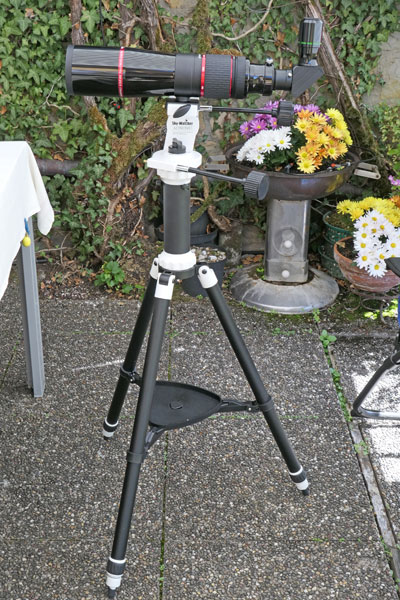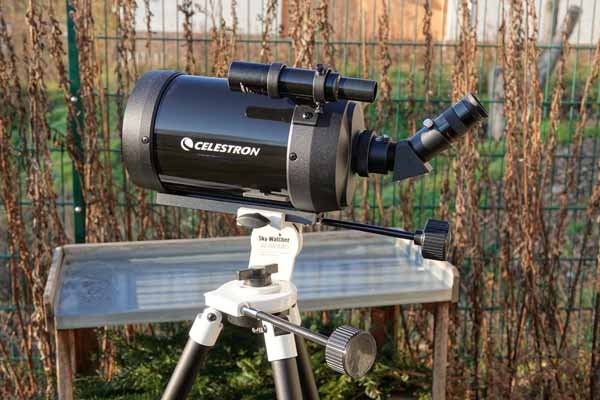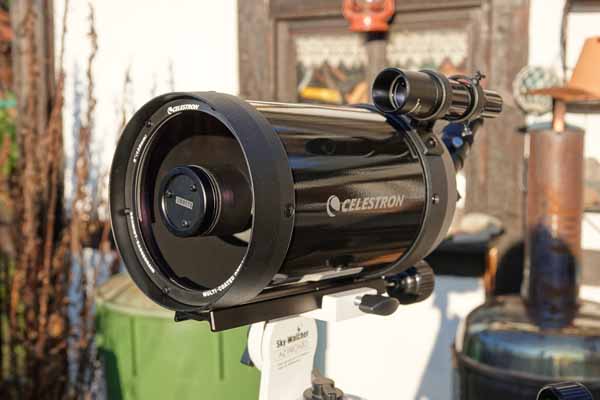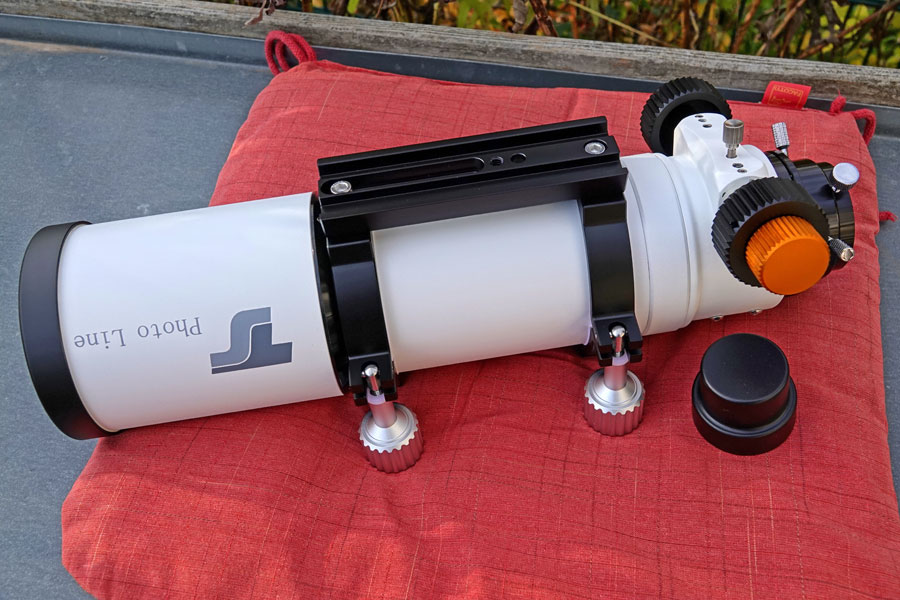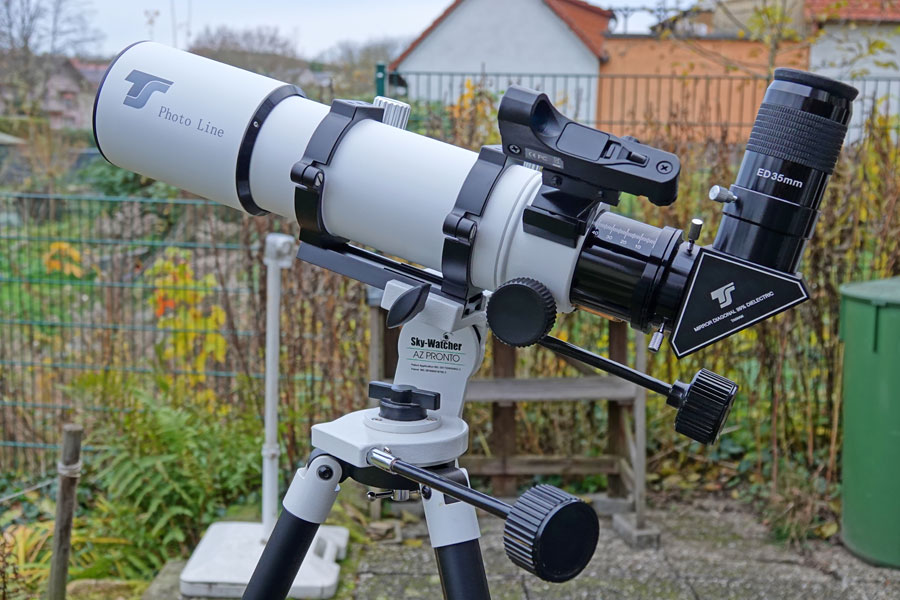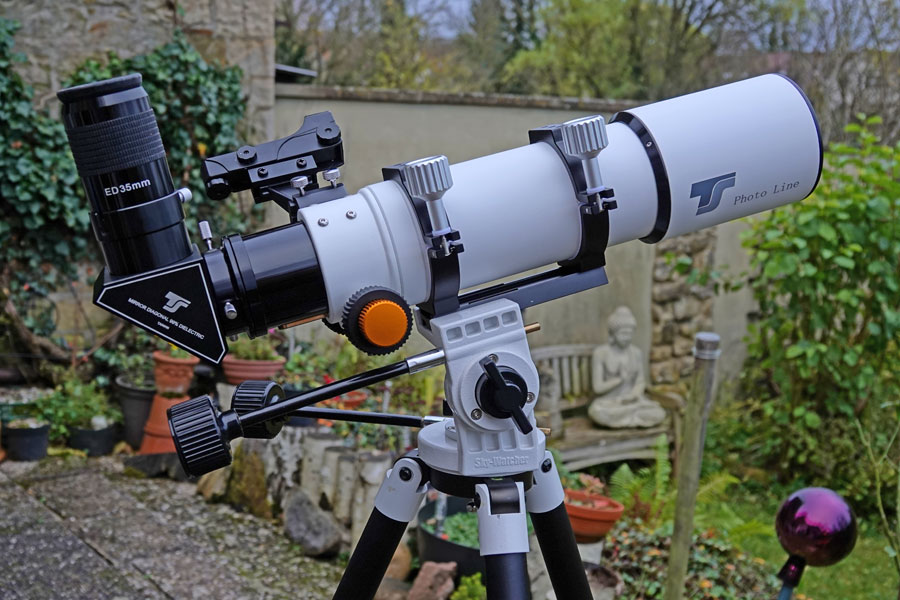Overview of My Current Telescopes
Introduction | Omegon Photography Scope 72/432 OTA | Celestron C8 OTA | Unistellar eVscope | TS-Optics Photoline 102/714 | Celestron C5 OTA | Vaonis Vespera | Unistellar eVscope 2 | Links | Appendix: Data of My Current Telescopes
On this page, I present some information about my current telescopes. Further below you will find a tabular overview of the basic data for the telescopes.
Note: Here you will find an overview of all telescopes that I own and owned. And here is my own little astronomy history.
Introduction
In the course of time, I have already tried a couple of telescopes and extended my "collection"several times, but also reduced again it at times. The reasons for the changes were of a different nature, and often the criteria "large aperture" and "weight/transportability" conflicted with each other. At the moment, my "collection" consists of the following tubes:
- Omegon Photography Scope 72/432 OTA (Refractor, doublet)
- Celestron C5 OTA (Schmidt-Cassegrain telescope)
- Vaonis Vespera Pro (Refractor, quadruplet, for EAA/video astronomy)
- TS-Optics TLAPO804 (Refractor, triplet)
The following overview lists the various options offered by the individual telescopes:
| Telescope | Omegon Photography Scope 72/432 OTA | TS-Optics TLAPO804 | Celestron C5 OTA | Vaonis Vespera Pro |
| Type | Refractor tube (doublet), also usable as a spotting scope and camera lens | Refractor tube (triplet), also usable as a spotting scope | Schmidt-Cassegrain scope for travel and fast observing | Refractor scope (quadruplet) with sensor chip, fully automated |
Data |
||||
| Aperture, Focal Length, Focal Ratio | 72 mm, 432 mm, f/6 | 80 mm, 480 mm, f/6 | 125/127 mm, 1250 mm, f/10 (9.84) | 50 mm, 250 mm, f/5 |
| Light Gathering Power, Limiting Visual Stellar Magnitude, Resolving Power | 105.8, 11.1 mag, 1.61" | 130.6, 11.5 mag, 1.45" * *) Dawes |
329, 13 mag, 0.91"/0.93" | 51.0, 16 mag, 2.32" |
| Maximum Magnification | 144 x | 160 x | 250/254 x | approx. 40 x???, > ??? x digitally |
| Magnification with 32 mm / 4 mm Eyepiece | 13.5 x / 108 x | 15 x / 120 x | 39 x / 312.5 (too high) => 250 x (5 mm) | --- |
Use |
||||
| Used as... | Telescope for travel and home use; telescope for a "quick look"; for moon, planets, and brighter deep sky objects; rich-field telescope; can be used as a spotting scope | Telescope for home use; telescope for a "quick look"; for moon, planets, and brighter deep sky objects; rich-field telescope; can be used as a spotting scope | Moon and planets telescope; travel scope; telescope for a "quick look"; best suited to moon, sun, and planets, but also suited to brighter deep sky objects; not quite, but nearly a rich-field telescope; can be used as a spotting scope | Telescope for EEA / "video astronomy" (rich-field telescope) |
| Usable with My AZ Pronto Mount? | yes | more or less... | yes | no, has its own AZ mount |
Observation |
||||
| Sun | yes (with solar filter size 4 - I do not own one) | yes (with solar filter size 4/5? - I do not own one) | yes (with solar filter size 6 that I own) | yes (with solar filter) |
| Moon | yes (I own a gray filter for the moon) | yes (I own a gray filter for the moon) | yes (I own a gray filter for the moon) | no (but not well suited to observing the moon) |
| Planets | yes-and-no (planets are rather small...) | yes-and-no (planets are rather small...) | yes, but the maximum usable magnification is about 250 x | no, tiny... |
| Deep Sky Objects | yes (the brighter ones; low magnification - rich-field observations) | yes (the brighter ones; low magnification - rich-field observations) | yes (the brighter ones) | yes |
| Terrestrial Observations | yes, with an Amici prism | yes, with an Amici prism | yes, with an Amici prism (is sold as a spotting scope) | no |
Further down, you will find a table with additional technical data for the telescopes.
Omegon Photography Scope 72/432 (September 2018)
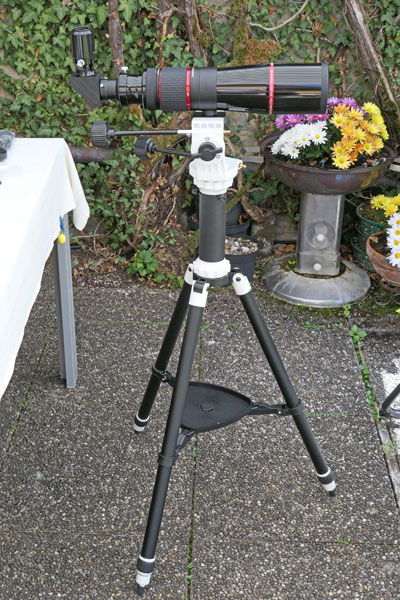 |
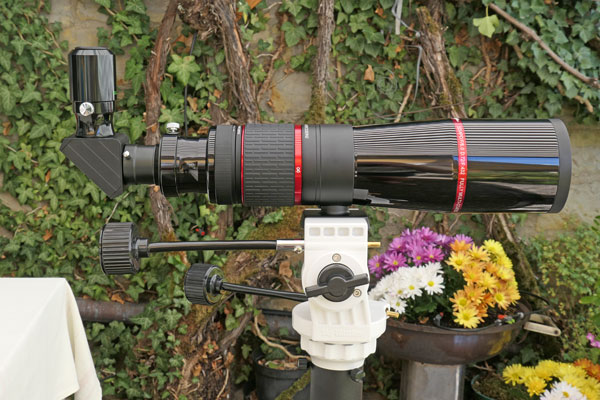 |
||
Side view on AZ Pronto mount with extension tube |
Ditto (detail) |
Other side, on AZ Pronto mount with extension tube |
Ditto (detail) |
Purchased in September 2018 at the AME2018 astronomy fair and delivered soon after. The Omegon Apochromatic Refractor Pro APO AP Photography Scope 72/432 ED OTA is a refractor tube, which is useful for observing the sun, the moon, and maybe the planets, but also for wide-field DSO observations. It can also be used as a spotting scope (with an Amici prism) and as a camera lens. Most of the time, I use the tube on the Sky-Watcher AZ Pronto mount. I wanted to use it on the Sky-Watcher Star Discovery AZ GoTo mount as well, but this did practically not happen. Later, I used it on the Sky-Watcher AZ-GTi GoTo mount head together with the tripod taken from the AZ Pronto mount.
For details see page Omegon Photography Scope 72/432 ED OTA Information (2.8" Refractor). For technical data see below.
Celestron C5 OTA (December 2020)
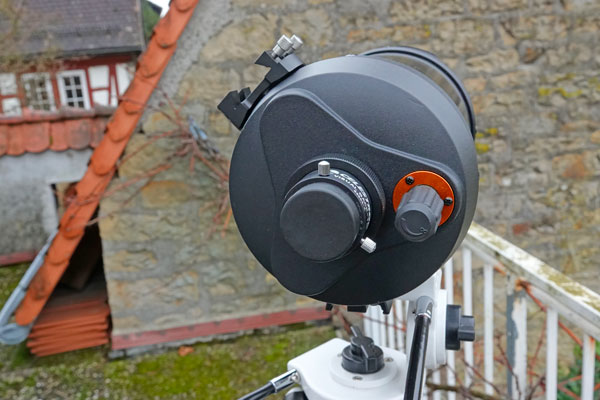 |
||
C5 - side view on the AZ Pronto mount with the original finder and as a spotting scope |
C5 tube, oblique front view |
C5 tube from the rear |
The Celestron C5 is a Schmidt-Cassegrain telescope which, like Maksutov-Cassegrains, is a reflector with a "folded" light path and therefore very compact for its large aperture. Accordingly, it has a long focal length, which makes it particularly suitable to observing the moon and the planets. However, the C5 is also suitable as a "universal telescope" for DSO, especially when using the f/6.3 reducer/corrector. However, this tube is marketed by Celestron as a spotting scope... Nevertheless, I call it here "OTA" and not "spotting scope". I bought the C5 in December 2020 in order to have a lighter and more flexible travel and "fast" telescope than the Skymax-127. I use(d) the C5 on my Sky-Watcher AZ Pronto mount and (as long as I owned it) on my Sky-Watcher AZ-GTi AZ GoTo mount (the bigger mounts are possible as well...)..
For details see page Celestron C5 OTA Information (5" Schmidt-Cassegrain). For technical data see below.
Vaonis Vespera Pro (May 2024)
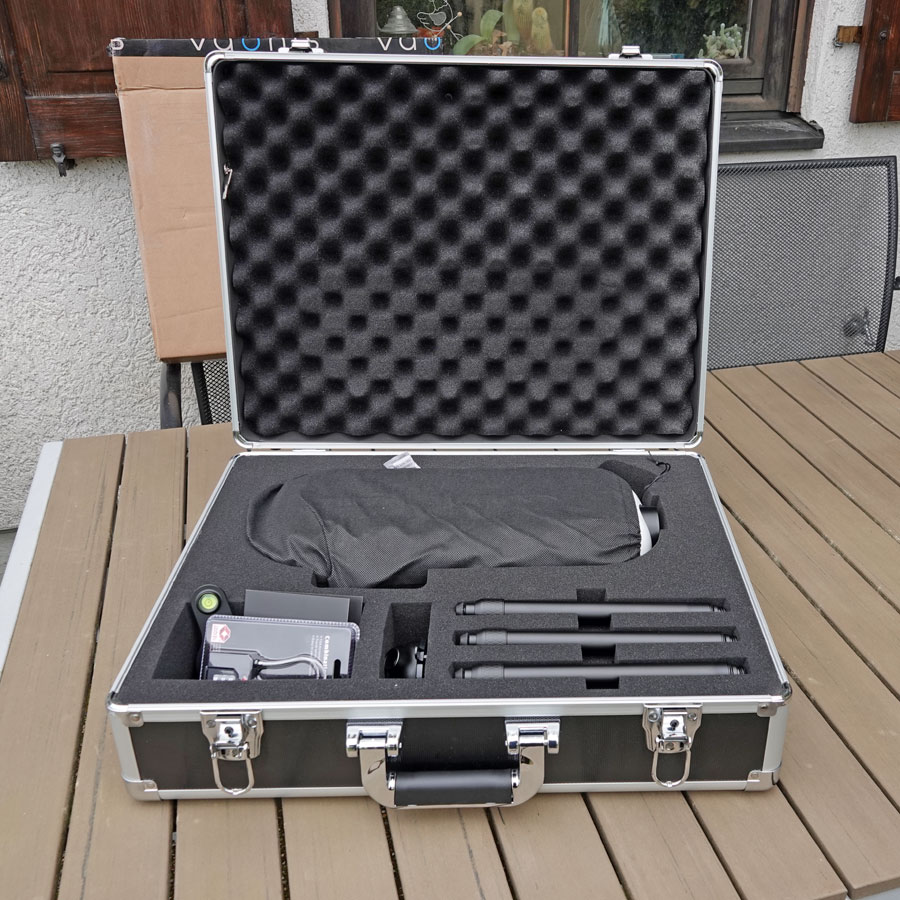 |
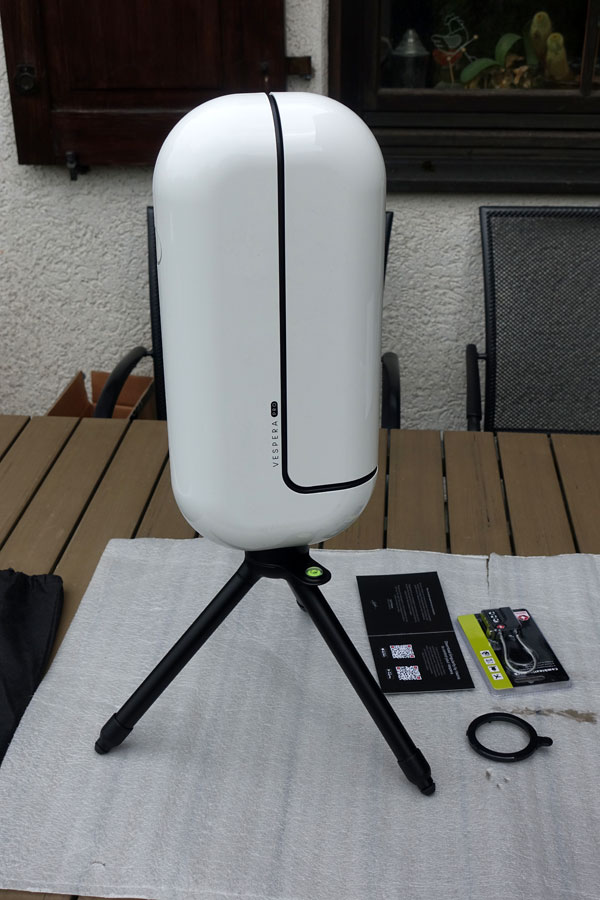 |
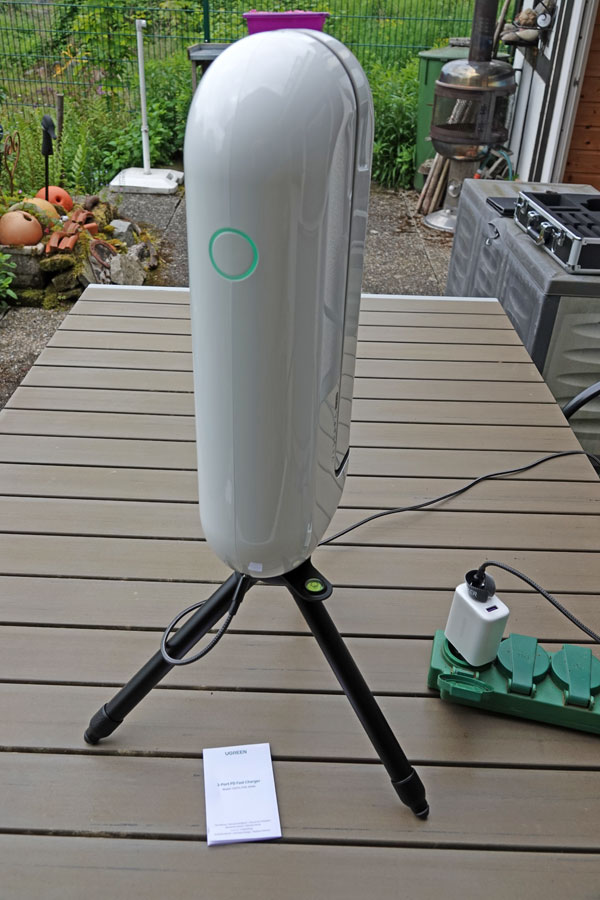 |
Photo: My Vaonis Vespera Pro (May 8, 2024)
Vespera Pro is an update of the telescope Vespera by the French company Vaonis. It could be preordered* since mid-June 2023 on the Vaonis Website. Delivery of the telescope was scheduled for May 2024; I received mine on May 8, 2024. Like the original Vespera, it is a refractor. The lens again is a quadruplet with 50 mm aperture (like binoculars), but with a focal length of 250 mm (aperture ratio f/5) and with a specially designed "pro" field corrector.
*) Since I already owned a high tripod, I decided to go for the simple package without an additional high tripod (2000 EUR instead of 2500 EUR).
The Vespera Pro uses a Sony IMX676 Starvis 2 sensor with a resolution of 3536 x 3536 pixels (12.5 MP). This delivers a field of view of 1.6° x 1.6° (3,2° x 3,2° in mosaic mode = 50 MP), which makes also the Vespera Pro a small rich field telescope. Its image scale or sampling rate is 1.65"/pixel, which is much better than that for the original Vespera (2.99"/pixel). With a weight of 5 kg and a height of 40 cm, the Vespera Pro has remained light and compact, making it an ideal travel telescope. The internal battery lasts for 11 hours, which is quite a long time.
For details see page Vaonis Vespera Pro - Information. For technical data see here.
TS-Optics TLAPO804 (November 2024)
The TS-Optics Photoline 80 mm f/6 FPL53 Triplet Apo with 2.5" RPA focuser is regarded as exhibiting very little color fringing with respect to its price. That is why I bought it in November 2024 in order to replace my Omegon refractor PS 72/432. However, I decided to keep my PS 72/432 and use it in our vacation apartment in Northern Germany.
I operate the refractor on my Sky-Watcher AZ Pronto mount and intend to use it only visually.
For details see page TS Optics Photoline 80/480 Information (3.2" Refractor). For technical data see here.
Links
- Omegon Photography Scope 72/432 ED OTA - Information (2.8" Refractor)
- Celestron C5 OTA - Information (5" Schmidt-Cassegrain)
- Vaonis Vespera Pro - Information
- TS Optics Photoline 80/480 - Information (3.2" Refractor)
Appendix: Data
Technical Data of My Current Telescopes
| Telescope | Omegon | Celestron | Vaonis | TS-Optics |
| PS 72/432 | C5 | Vespera Pro | TLAPO804 | |
| Optical Design | Refractor (Doublet) | Schmidt-Cassegrain | Refractor (Quadruplet) | Refractor (triplet) |
| Primary Mirror Diameter | 72 mm (2.8") | 125/127 mm (5") | 50 mm (2") | 80 mm (3.2") |
| Focal Length, Focal Ratio | 432 mm f/6 |
1250 mm f/10 (9.84) |
250 mm f/5 |
480 mm f/6 |
| Resolving Power (arc secs) | 1.61" ** | 0.91"/0.93" | 2.32" | 1.45" |
| Limiting Visual Stellar Magnitude | 11.1 mag ** | 13 mag | 16 mag | 11.5 mag |
| Light Gathering Power | 105.8 ** | 329 | 51.0 | 130.6 |
| Maximum Practical Visual Power | 144 x | 250/254 x | 40 x???, ??? digitally | 160 x |
| Optical Tube Dimensions (diam. x length) |
10 cm x 39.4 cm | 15 cm* x 28/33 cm | 48 x 20 x 9 cm (HxWxD) | 8.9/10.3 cm x 37.5 cm (transport size) |
| Net Weight Basis | --- | --- | --- | --- |
| Net Weight Optical Tube | 2.06 kg | 2.72 kg | 5 kg (everything) | 3,1 kg (with pipe clamps) |
*) My own measurement; **) corrected values
Observation-Relevant Data
| Telescope | Focal |
Aperture (mm) |
Focal Ratio |
Light Gathering Power |
Maximum+ |
Minimum* |
Maximum* |
Minimum+ |
|||||
Usable Magnification |
Usable Focal
Length of Eyepiece (mm) |
||||||||||||
Factor/Exit Pupil (mm) > |
Manuf. |
1.5 |
2 |
6.5 |
7 |
6.5 |
7 |
1.5 |
2 |
||||
| PS 72 (Refractor, Doublet) | 432 |
72 |
6 |
106 |
144 |
108 |
144 |
11.08 |
10.29 |
39.0 |
42.0 |
4.0 |
3.0 |
| TLAPO804 (Refractor, Triblet) | 480 |
80 |
6 |
130.6 |
120 | 160 | 12.31 | 11.43 | 39.0 |
42.0 |
4.0 |
3.0 |
|
| Celestron C5 (Schmidt-Cassegrain) | 1250 |
127 |
10 |
329 |
295 |
190 |
254 |
19.69 | 18.29 | 65.0 |
70.0 |
6.7 |
5.0 |
| Celestron C5R (Schmidt-Cassegrain) | 787.5 |
127 |
6.3 |
329 |
295 |
190 |
254 |
19.69 | 18.29 | 41.0 |
44.1 |
4.2 |
3.2 |
*) Calculated for an exit pupil of 6.5 mm and 7 mm
+) Factor 1.5 or 2 for Dobsonian telescopes; in general, the lower value of
1.5 is used for Newtonian telescopes; if the manufacturer specified a different
magnification, it is also listed (some manufacturer provide considerably
higher numbers...).
Visual Power (Magnification), True Field of View, and Exit Pupil for Different Focal Lengths of Eyepieces
Blue: borrowed eyepieces; italic 2" eyepiece; gray: sold
| Telescope | Further Data |
Focal Length of Eyepiece (mm) |
||||||||||||
| Magnification | ||||||||||||||
Focal Length of Telescope (mm) |
4 |
7 |
10 |
16 |
18 |
24 |
26 |
32 |
32 |
35 |
38 |
40 |
56 |
|
| PS 72/432 | 432 |
108.00 |
61.71 |
43.20 |
27.00 |
24.00 |
18.00 |
16.62 |
13.50 |
13.50 |
12.34 |
11.37 |
10.80 |
7.71 |
| TLAPO804 | 480 |
|||||||||||||
| C5 | 1250 |
312.50 |
178.57 |
125.00 |
78.13 |
--- |
52.08 |
--- |
39.06 |
--- |
--- |
--- |
--- |
--- |
| C5 (Red.) | 787.5 |
196.88 |
112.50 |
78.75 |
49.22 |
--- |
32.81 |
--- |
24.61 |
--- |
--- |
--- |
--- |
--- |
| True Field of View (°) | ||||||||||||||
Apparent Field
of View (°) > |
82 |
82 |
72 |
82 |
82 |
65 |
70 |
52 |
70 |
69 |
70 |
68 |
52 |
|
Focal Length of Telescope (mm) |
4 |
7 |
10 |
16 |
18 |
24 |
26 |
32 |
32 |
35 |
38 |
40 |
56 |
|
| PS 72/432 | 432 |
0.76 |
1.33 |
1.67 |
3.04 |
3.42 |
3.61 |
4.21 |
3.85 |
5.19 |
5.59 |
6.16 |
6.30 |
6.74 |
| TLAPO804 | 480 |
120.00 |
68.57 |
48.00 |
30.00 |
26.67 |
20.00 |
18.46 |
15.00 |
15.00 |
13.71 |
12.63 |
12.00 |
8.57 |
| C5 | 1250 |
0.26 |
0.46 |
0.58 |
1.05 |
--- |
1.25 |
--- |
1.33 |
--- |
--- |
--- |
--- |
--- |
| C5 (Red.) | 787.5 |
0.42 |
0.73 |
0.91 |
1.67 |
--- |
1.98 |
--- |
2.11 |
--- |
--- |
--- |
--- |
--- |
| Exit Pupil (mm) | ||||||||||||||
Focal Ratio |
4 |
7 |
10 |
16 |
18 |
24 |
26 |
32 |
32 |
35 |
38 |
40 |
56 |
|
| PS 72/432 | 6 |
0.67 |
1.17 |
1.67 |
2.67 |
3.00 |
4.00 |
4.33 |
5.33 |
5.33 |
5.83 |
6.33 |
6.67 |
9.33 |
| TLAPO804 | 6 |
0.67 |
1.17 |
1.67 |
2.67 |
3.00 |
4.00 |
4.33 |
5.33 |
5.33 |
5.83 |
6.33 |
6.67 |
9.33 |
| C5 | 10 |
0.41 |
0.71 |
1.02 |
1.63 |
--- |
2.44 |
--- |
3.25 |
--- |
--- |
--- |
--- |
--- |
| C5 (Red.) | 6.3 |
0.65 |
1.13 |
1.61 |
2.58 |
--- |
3.87 |
--- |
5.16 |
--- |
--- |
--- |
--- |
--- |
Magnification: Yellow: low (30-50 x); magenta: medium (80-100 x); violet: high (150-200 x - and more); red: beyond maximum usable magnification.
Field of View: Allows to predict whether an extended object can be fully captured or whether adjacent objects can be observed together.
Exit pupil: Values in magenta cells are either too small (< 1 mm) or too large (> 6.4/7 mm); yellow background: best for galaxies (about 2-3 mm).
| 30.11.2024 |
